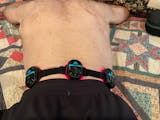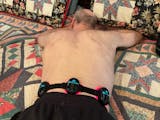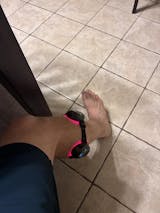How to Sleep with Lower Back Pain

If you're dealing with lower back pain, trying to get a good night's sleep can be a real struggle. Whether the pain is caused by a recent injury, poor posture, or a chronic condition, finding the right sleeping positions and supportive tools can make a significant difference. In this article, we’ll explore some effective strategies, including the use of medical-grade red light therapy devices, to help you manage lower back pain and sleep better.
Best Sleeping Positions for Lower Back Pain
Sleeping on Your Back with Proper Support
Sleeping on your back can often be the most comfortable position for people with lower back pain, as it helps distribute your body weight evenly. To enhance comfort and reduce pressure, place a pillow underneath your knees. This allows your spine to maintain a natural curve, providing the right support and reducing discomfort.
Sleeping on Your Side with a Pillow Between Your Knees
If you find sleeping on your back uncomfortable, side sleeping might work better for you. When sleeping on your side, placing a pillow between your knees helps keep your hips aligned and reduces strain on your lower back. This small adjustment can go a long way in minimizing pain throughout the night.
Avoid Sleeping on Your Stomach
Sleeping on your stomach can put a lot of strain on your neck and spine, exacerbating lower back pain. The unnatural position of your head and neck can create tension in the upper spine, which in turn affects the lower back. For a more comfortable sleep, it’s best to avoid sleeping on your stomach altogether.

How to Choose the Right Mattress for Lower Back Pain
Medium-Firm Mattresses Are Ideal
A medium-firm mattress is often recommended for people dealing with lower back pain. It provides the perfect balance between support and comfort, keeping your spine aligned without sinking too deeply into the mattress. A mattress that’s too soft can worsen back pain by offering insufficient support, while a mattress that's too firm may cause pressure points.
Memory Foam vs. Innerspring Mattresses
When it comes to choosing between memory foam and innerspring mattresses, the decision largely depends on your personal comfort preferences. Memory foam conforms to your body shape, relieving pressure points and offering excellent comfort for lower back pain. On the other hand, innerspring mattresses provide more firm support, which some people may prefer for spinal alignment.
Consider an Adjustable Bed
An adjustable bed can be a game-changer for those with lower back pain. These beds allow you to raise or lower your head or feet, which can provide relief by reducing pressure on your spine. Being able to customize your sleep position based on your pain level may significantly improve your sleep quality.
The Role of Pillows in Managing Lower Back Pain
Lumbar Pillows for Extra Support
If you're sleeping on your back, a lumbar pillow can provide much-needed support for your lower back. These pillows help maintain the natural curve of your spine, reducing strain and preventing further discomfort. You can also use them while sitting to support your back during the day.
Knee Pillows for Side Sleepers
For side sleepers, using a knee pillow is an easy way to keep your spine aligned and reduce pressure on your lower back. This simple addition can make a noticeable difference in how you feel when you wake up, ensuring that your spine stays in a neutral position throughout the night.
Avoiding Too Many Pillows Under Your Head
While a pillow under your head is essential, it’s important not to overdo it. Using too many pillows can cause your neck to be misaligned, which can then lead to more back pain. Stick to one supportive pillow that keeps your neck in a neutral position, promoting overall spinal health.
How to Use Heat and Cold Therapy for Lower Back Pain at Night
Applying Heat Before Bed
Heat therapy is a great way to relieve muscle tension and increase blood flow to your lower back before bed. You can use a heating pad, warm compress, or even a hot water bottle to target areas of pain. Applying heat for about 20 minutes can help loosen tight muscles and prepare your back for a more restful sleep.
Cold Therapy for Inflammation
If your lower back pain is caused by inflammation, cold therapy can help reduce swelling and numb the area to alleviate discomfort. Using an ice pack for 15-20 minutes before bed can help ease inflammation and provide relief, especially if the pain is due to a recent injury.

Using a Combination of Heat and Cold Therapy
Alternating between heat and cold therapy can be an effective strategy for managing lower back pain. Start with cold therapy to reduce inflammation and follow up with heat therapy to relax muscles and increase circulation. This combination can help you feel more comfortable as you settle in for the night.
The Benefits of Red Light Therapy Devices for Lower Back Pain
How Red Light Therapy Works
Red light therapy devices work by emitting low-level wavelengths of light that penetrate deep into the skin. This therapy helps stimulate cellular repair and reduces inflammation in tissues, offering a non-invasive way to manage lower back pain. Regular use can help reduce pain and improve your overall well-being.
How to Incorporate Red Light Therapy into Your Sleep Routine
You can incorporate FDA approved red light therapy into your bedtime routine by using a red light therapy panel or mask. Apply it for about 15-20 minutes before bed to promote muscle relaxation and pain relief. This can help your back feel less stiff and sore, allowing you to sleep more soundly.
Choosing the Right Red Light Therapy Device
When selecting a red light therapy machine, it's important to focus on a few key factors to ensure you get the most effective treatment. Here’s how you can make the right choice:
-
Wavelength: Choose a machine with a wavelength between 600-650 nm for optimal skin and tissue benefits.
-
Power Output: Ensure the device has a high enough power output to penetrate deeply into the skin, typically around 100-200mW/cm².
-
Treatment Area: Select a device with a suitable treatment area to cover the target region effectively.
-
Portability: Depending on your needs, choose between handheld devices for localized treatment or panels for larger areas. If you're considering handheld modules, you might want to check out PRUNGO FluxGo.
-
Safety Features: Look for certifications and safety features, such as automatic shut-off, to ensure safe use.

Exercises and Stretches to Relieve Lower Back Pain Before Bed
Gentle Stretches to Prepare for Sleep
Incorporating gentle stretches into your bedtime routine can help relax tight muscles in your lower back. Stretches like the cat-cow stretch, pelvic tilts, and knee-to-chest stretch are all great options. These stretches can increase flexibility and reduce the tension that may contribute to your pain.
Core Strengthening Exercises for Long-Term Relief
Building a strong core is key to preventing future lower back pain. Incorporate core-strengthening exercises such as planks and bridges into your daily routine. A strong core supports your spine and can reduce the strain on your lower back during everyday activities.
Avoid Intense Physical Activity Before Bed
While regular exercise is beneficial, intense physical activity before bed may leave you feeling too energized to sleep well. To ensure a restful night, try to finish your workouts at least a few hours before bedtime.
Tips for Creating a Comfortable Sleep Environment
Keep Your Bedroom Cool and Dark
Creating a sleep-friendly environment is essential for managing back pain. Make sure your bedroom is cool, dark, and quiet. A temperature-controlled room helps your body relax, while darkness signals to your brain that it’s time to wind down.
Reduce Noise and Distractions
Use Relaxation Techniques Before Bed
Incorporating relaxation techniques like deep breathing, meditation, or progressive muscle relaxation can help calm your body and prepare you for a restful sleep. These techniques can also reduce the emotional stress that might contribute to physical tension in your lower back.
Conclusion
Even with severe back pain, achieving quality sleep is possible. By adjusting your sleeping position, choosing the right mattress, and optimizing your sleep environment, you can significantly reduce discomfort. Hot and cold therapies, along with medical-grade red light therapy devices, can further aid in pain relief and relaxation. For larger areas, red light panels are an excellent choice. For facial care, red light masks target multiple areas, making them ideal for anti-aging, soothing, and skin repair, while helping to improve skin health and reduce acne.




















0 comments